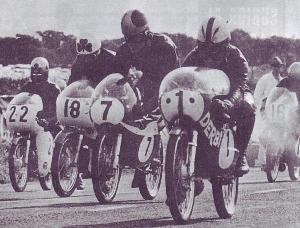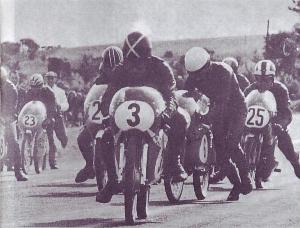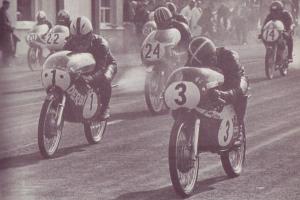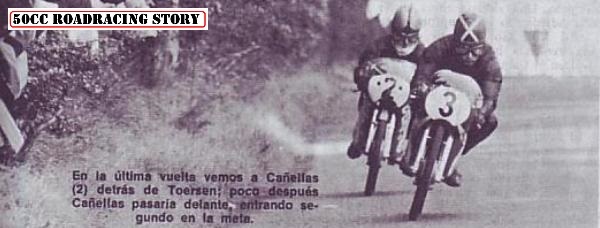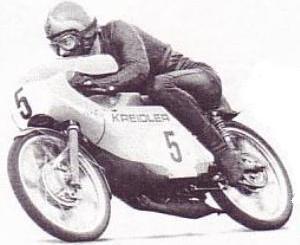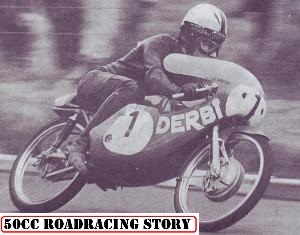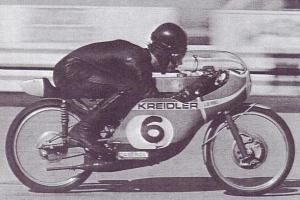1970
The 1970 season saw some changes. Paul Lodewijkx got involved in a nasty traffic accident that, although he recovered well, ended his career as an active racer.
Due to personal problems, Van Veen's race manager Jan Leferink was sacked. This caused Aalt Toersen and technician Jan Smit to quit Van Veen, whereupon Toersen joined Jamathi to take Lodewijkx's place. Barry Smith quit Derbi and racing altogether, and was replaced by Salvador Canellas.
The season started with the German GP on the Nurburgring, one of the most difficult circuits of Europe, which was run in disastrous weather, made even worse by the then idiotic habit of the Germans of running car races the same days as the motorcycle GP, causing the track to become extremely slippery due to the rubber left by the cars. This caused many falls, killing Robin Fitton and putting many, some badly wounded, in hospital. Furthermore there was too little time for practice, which was a great disadvantage for the Dutch, to whom the circuit was new. The results were: 1. A. Nieto (Derbi), 2. R. Kunz (Kreidler), 3. G. Parlotti (Tomos), 4. S. Canellas (Derbi), 5. E. Lazzarini (Morbidelli), 6. O. Buscherini (Honda).
Next was the French GP at Le Mans, with Nieto winning again, followed by 2. A. Toersen (Jamathi), 3. R. Kunz (Kreidler), 4. J. Schurgers (Van Veen Kreidler), 5. M. Mijwaart (Jamathi) and 6. S. Canellas (Derbi).
In the Dutch TT, Aalt Toersen fell off while leading the race, and broke his front brake lever. He struggled on without his front brake, and the finishing sequence was 1. Nieto (Derbi), 2. J. de Vries (Van Veen Kreidler), 3. S. Canellas (Derbi), 4. R. Kunz (Kreidler), 5. A. Toersen (Jamathi), 6. G. Parlotti (Tomos).
Next came Francorchamps in Belgium, where they finished 1. A. Toersen (Jamathi), 2. A. Nieto (Derbi), 3. J. Schurgers (Van Veen Kreidler), 4. S. Canellas (Derbi), 5. M. Mijwaart (Jamathi), and 6. J. de Vries (Van Veen Kreidler).
The East German GP was won by A. Toersen (Jamathi), followed by 2. J. Schurgers (Van Veen Kreidler), 3. A. Nieto (Derbi), 4. M. Mijwaart (Jamathi), 5. J. de Vries (Van Veen Kreidler) and 6. R. Kunz (Kreidler).
The GP of Czechoslovakia resulted in 1. A. Toersen (Jamathi), 2. R. Kunz (Kreidler), 3. S. Canellas (Derbi), 4. M. Mijwaart (Jamathi), 5. M. Stripacuk (Jamathi) and 6. L. Rinaudo (Tomos).
During the Ulster GP at last Nieto returned to the winners rostrum, the end result being 1. A. Nieto (Derbi), 2. S. Canellas (Derbi), 3. A. Toersen (Jamathi), 4. R. Kunz (Kreidler), 5. M. Mijwaart (Jamathi) and 6. J. de Vries (Van Veen Kreidler).
In Monza, Jos Schurgers fell in the Curva Parabolica, and the directly behind him riding Toersen and Canellas couldn't avoid him and fell too. Nieto's Derbi seemed also not to be in top condition, and in the end he had to retire with burst water hose, and so the riders finished 1. J. de Vries (Van Veen Kreidler), 2. R. Kunz (Kreidler), 3. L. Fassbender (Kreidler), 4. B. Cretti (Malanca), 5. A. Millard (Kreidler) and 6. M. Mijwaart (Jamathi). These results gave Nieto the world championship again.
The last GP of the season was Barcelona, and here Canellas won on the Derbi, followed by 2. R. Kunz (Kreidler), 3. J. de Vries (Van Veen Kreidler), 4. A. Nieto (Derbi), 5. J. Bordons (Derbi) and 6. U. Graf (Kreidler). The Jamathis of both Toersen and Mijwaart retired in the third lap.
The world championship was won by A. Nieto (Derbi), followed by A. Toersen (Jamathi), R. Kunz (Kreidler), S. Canellas (Derbi), M. Mijwaart (Jamathi) and J. Schurgers (Van Veen Kreidler).
J. Kortekaas 2006.
|
The Bikes
Derbi
No changes to the Derbis, compared with 1969, are known, except that the power was now some 17 bhp at 16,000 rpm. The reliability, compared to 1969, was vastly improved. In '69, Nieto had to stay 1000 revs below maximum, to keep the big-end whole, something he tended to forget from time to time in the heat of the fight, with predictable results.
|
 |
 |
Jamathi
The Jamathis for 1970 (see pic. Jamathi11) were practically the same as the ones used during 1969, except they had new cylinders and now used a Bing carburettor. A try-out with BVF carburettors was abandoned because they were too difficult to tune. The mechanically driven water pump found a place behind the clutch, where formerly the drive to the rev. counter was situated. The clusters of the 6-speed gearbox could easily be switched for clusters with different ratios, to suit the various circuits
|
Van Veen Kreidler
The Van Veen Kreidlers were less successful than the previous year, and this might have had something to do with the disappearance of Aalt Toersen and Jan Smit. The bikes have already been described under 1969. Noteworthy is, that the engines now had an oil pump, next to the petrol/oil mixture, to transport oil to critical places.
|
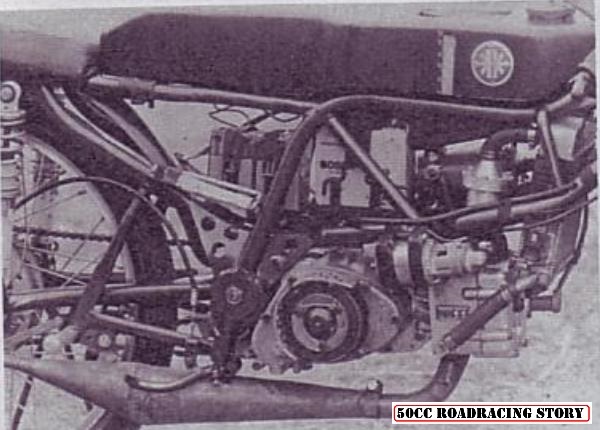 |
| |
Malanca
A newcomer was the Malanca (See pics Malanca1 and 2). The engine was a water-cooled two-stroke (the water cooling also included the crankcase, just like the Derbis), with rotating inlet with Dell'Orto 28 mm carburettor and electronic ignition. Dry clutch to the six-speed gearbox. Bore and stroke were 40 x 39.5. No power output was given, max. engine speed 17,000 rpm. Weight 62 kg, tyre sizes 2.00-18 front, 2.25-18 rear. I can't say that the way those holes were drilled in the upper frame tube looks very professional!
|
|
|







































